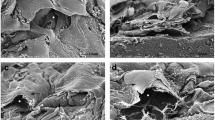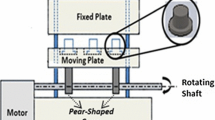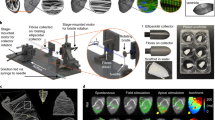Abstract
Transport limitations of critical nutrients are a major obstacle in the construction of engineered heart tissues (EHTs), and the importance of oxygen in this regard is well-documented throughout the literature. An indirect effect of cellular hypoxia is the shunt to the less-efficient glycolytic metabolism, which is accompanied by a reduction in extracellular pH. Image analysis of phenol red coloration in an experimental model of EHTs demonstrated pH gradients towards the center of the construct, which were dependent on experimental variables. Based on these observations, a four-species, 2-D diffusion–reaction mathematical model was developed to predict pH in a radial-diffusion model. The mathematical model predicted lethal values of pH (<6.5) in EHTs comprised of a nominal cell density of 106 cells/cm3. pH predictions were moderately dependent on O2 concentration, and strongly dependent on cell density, CO2 concentration, and diffusion path length. It can be concluded from this study that hypoxia-induced acidosis is an important element in the mass transport problem, and future experiments measuring pH with more sensitive methods is expected to further elucidate the extent of this effect.
















Similar content being viewed by others
References
Aki T., Y. Mizukami, Y. Oka, K. Yamaguchi, K. Uemura, T. Fujimiya, K. Yoshida 2001 Phosphoinositide 3-kinase accelerates necrotic cell death during hypoxia. Biochem. J. 358:481–487
Bonarius H. P. J., C. D. de Gooijer, J. Tramper, G. Schmid 1994 Determination of the respiration quotient in mammalian cell culture in bicarbonate buffered media. Biotech. Bioeng. 45:524–535
Brown, D. A., W. R. MacLellan, H. Laks, J. C. Dunn, B. M. Wu, and R. E. Beygui. Analysis of oxygen transport in a diffusion-limited model of engineered heart tissue. Biotechnol. Bioeng. 97:962–975, 2007
Carrier R. L., M. Papadaki, M. Rupnick, F. J. Schoen, N. Bursac, R. Langer, L. E. Freed, G. Vunjak-Novakovic 1999 Cardiac tissue engineering: cell seeding, cultivation parameters, and tissue construct characterization. Biotechnol. Bioeng. 64:580–589
Carrier R. L., M. Rupnick, R. Langer, F. J. Schoen, L. E. Freed, G. Vunjak-Novakovic 2002 Effects of oxygen on engineered cardiac muscle. Biotechnol. Bioeng. 78:617–625
Carrier R. L., M. Rupnick, R. Langer, F. J. Schoen, L. E. Freed, G. Vunjak-Novakovic 2002 Perfusion improves tissue architecture of engineered cardiac muscle. Tissue Eng. 8:175–188
Casey T. M., P. G. Arthur 2000 Hibernation in noncontracting mammalian cardiomyocytes. Circulation 102:3124–3129
Casey T. M., J. L. Pakay, M. Guppy, P. G. Arthur 2002 Hypoxia causes downregulation of protein and RNA synthesis in noncontracting Mammalian cardiomyocytes. Circ. Res. 90:777–783
Chang H., T. Fujita 2001 A numerical model of acid-base transport in rat distal tubule. Am. J. Physiol. Renal Physiol. 281:F222–F243
Chen Q. M., V. C. Tu, Y. Wu, J. J. Bahl 2000 Hydrogen peroxide dose dependent induction of cell death or hypertrophy in cardiomyocytes. Arch. Biochem. Biophys. 373:242–248
Costa L. E., G. Mendez, A. Boveris 1997 Oxygen dependence of mitochondrial function measured by high-resolution respirometry in long-term hypoxic rats. Am. J. Physiol. 273:C852–C858
Crank, J. 1975 The Mathematics of Diffusion. New York: Oxford University Press
Douglas R., N. L. Jones, J. W. Reed 1988 Calculation of whole blood CO2 content. J. Appl. Physiol. 65:473–477
Eigen M. 1964 Proton transfer, acid-base catalysis, and enzymatic hydrolysis. Angew. Chem. 3:1–19
Eschenhagen T., M. Didie, J. Heubach, U. Ravens, W. H. Zimmermann 2002 Cardiac tissue engineering. Transpl. Immunol. 9:315–321
Eschenhagen T., C. Fink, U. Remmers, H. Scholz, J. Wattchow, J. Weil, W. Zimmermann, H. H. Dohmen, H. Schafer, N. Bishopric, T. Wakatsuki, E. L. Elson 1997 Three-dimensional reconstitution of embryonic cardiomyocytes in a collagen matrix: a new heart muscle model system. FASEB J. 11:683–694
Garg L. C., T. H. Maren 1972 The rates of hydration of carbon dioxide and dehydration of carbonic acid at 37 degrees. Biochim. Biophys. Acta 261:70–76
Geers C., G. Gros 2000 Carbon dioxide transport and carbonic anhydrase in blood and muscle. Physiol. Rev. 80:681–715
Kellner K., G. Liebsch, I. Klimant, O. S. Wolfbeis, T. Blunk, M. B. Schulz, A. Gopferich 2002 Determination of oxygen gradients in engineered tissue using a fluorescent sensor. Biotechnol. Bioeng. 80:73–83
Kreutzer U., T. Jue 1995 Critical intracellular O2 in myocardium as determined by 1H nuclear magnetic resonance signal of myoglobin. Am. J. Physiol. 268:H1675–H1681
Kubasiak L. A., O. M. Hernandez, N. H. Bishopric, K. A. Webster 2002 Hypoxia and acidosis activate cardiac myocyte death through the Bcl-2 family protein BNIP3. Proc. Natl. Acad. Sci. USA 99:12825–12830
Morsiani E., M. Brogli, D. Galavotti, T. Bellini, D. Ricci, P. Pazzi, A. C. Puviani 2001 Long-term expression of highly differentiated functions by isolated porcine hepatocytes perfused in a radial-flow bioreactor. Artif. Organs 25:740–748
Murray F. W. 1967 On the computation of saturation vapor pressure. J. Appl. Meteor. 6:203–204
Nelson D. L., M. M. Cox 2000 Lehninger Principles of Biochemistry. New York: Worth Publishers
Netti P. A., D. A. Berk, A. Swartz, A. J. Grodzinsky, R. K. Jain 2000 Role of extracellular matrix assembly in interstitial transport in solid tumors. Cancer Res. 60:2497–2503
Noll T., A. Koop, H. M. Piper 1992 Mitochondrial ATP-synthase activity in cardiomyocytes after aerobic-anaerobic metabolic transition. Am. J. Physiol. 262:C1297–C1303
Opie, L. H. 1991 The Heart. Physiology and Metabolism. New York: Raven
Papadaki M., N. Bursac, R. Langer, J. Merok, G. Vunjak-Novakovic, L. E. Freed 2001 Tissue engineering of functional cardiac muscle: molecular, structural, and electrophysiological studies. Am. J. Physiol. Heart Circ. Physiol. 280:H168–H178
Probst I., R. Spahr, C. Schweickhardt, D. H. Hunneman, H. M. Piper 1986 Cardohydrate and fatty acid metabolism of cultured adult cardiac myocytes. Am. J. Physiol. 250:H853–H860
Radisic M., J. Malda, E. Epping, W. Geng, R. Langer, G. Vunjak-Novakovic 2006 Oxygen gradients correlate with cell density and cell viability in engineered cardiac tissue. Biotechnol. Bioeng. 93:332–343
Radisic M., H. Park, H. Shing, T. Consi, F. J. Schoen, R. Langer, L. E. Freed, G. Vunjak-Novakovic 2004 Functional assembly of engineered myocardium by electrical stimulation of cardiac myocytes cultured on scaffolds. Proc. Natl. Acad. Sci. USA 101:18129–18134
Ramanujan S., A. Pluen, T. D. McKee, E. B. Brown, Y. Boucher, R. K. Jain 2002 Diffusion and convection in collagen gels: implications for transport in the tumor interstitium. Biophys. J. 83:1650–1660
Ross R. S., C. Pham, S. Y. Shai, J. I. Goldhaber, C. Fenczik, C. C. Glembotski, M. H. Ginsberg, J. C. Loftus 1998 Beta1 integrins participate in the hypertrophic response of rat ventricular myocytes. Circ. Res. 82:1160–1172
Royce P. N., N. F. Thornhill 1991 Estimation of dissolved carbon dioxide concentrations in aerobic fermentations. AIChE J. 37:1680–1686
Stumpe T., J. Schrader 1997 Phosphorylation potential, adenosine formation, and critical PO2 in stimulated rat cardiomyocytes. Am. J. Physiol. 273:H756–H766
Vannucci R. C., R. M. Brucklacher, S. J. Vannucci 1997 Effect of carbon dioxide on cerebral metabolism during hypoxia-ischemia in the immature rat. Pediatr. Res. 42:24–29
Vannucci R. C., J. Towfighi, D. F. Heitjan, R. M. Brucklacher 1995 Carbon dioxide protects the perinatal brain from hypoxic-ischemic damage: an experimental study in the immature rat. Pediatrics 95:868
Vanysek, P. Ionic conductivity and diffusion at infinite dilution. In: CRC Handbook of Chemistry and Physics, Thermochemistry, Electrochemistry and Kinetics. London: CRC Press, 1999, pp. 93–95
Vesela A., J. Wilhelm 2002 The role of carbon dioxide in free radical reactions of the organism. Physiol. Rev. 51:335–339
Webster K. A., N. Bishopric 1992 Molecular regulation of cardiac myocyte adaptation to chronic hypoxia. J. Mol. Cell. Cardiol. 24:741–751
Webster K. A., D. J. Discher, S. Kaiser, O. Hernandez, B. Sato, N. H. Bishopric 1999 Hypoxia-activated apoptosis of cardiac myocytes requires reoxygenation or a pH shift and is independent of p53. J. Clin. Invest. 104:239–252
Westrin B. A., Axelsson A. 1991 Diffusion in gels containing immobilized cells: a critical review. Biotechnol. Bioeng. 38:439–446
Wise D. L., G. Houghton 1966 The diffusion coefficients of ten slightly soluble gases in water at 10–60 deg C. Chem. Eng. Sci. 21:999–1010
Wittenberg B. A., J. B. Wittenberg 1989 Transport of oxygen in muscle. Annu. Rev. Physiol. 51:857–878
Zimmermann W. H., M. Didie, G. H. Wasmeier, U. Nixdorff, A. Hess, I. Melnychenko, O. Boy, W. L. Neuhuber, M. Weyand, T. Eschenhagen 2002 Cardiac grafting of engineered heart tissue in syngenic rats. Circulation 106:I151–I157
Zimmermann W. H., C. Fink, D. Kralisch, U. Remmers, J. Weil, T. Eschenhagen 2000 Three-dimensional engineered heart tissue from neonatal rat cardiac myocytes. Biotechnol. Bioeng. 68:106–114
Zimmermann W. H., K. Schneiderbanger, P. Schubert, M. Didie, F. Munzel, J. F. Heubach, S. Kostin, W. L. Neuhuber, T. Eschenhagen 2002 Tissue engineering of a differentiated cardiac muscle construct. Circ. Res. 90:223–230
Acknowledgments
The authors would like to acknowledge Prof. Daniel Kamei of the Department of Bioengineering for his assistance in formulating the diffusion–reaction model, as well as Mrs. Jane Chen of the Department of Medicine for harvesting the cardiomyocytes. This work was supported by the Fubon Foundation.
Author information
Authors and Affiliations
Corresponding author
Appendix: Mathematical Model Formulation
Appendix: Mathematical Model Formulation
A mathematical model was constructed to aid in the prediction of pH inside diffusion-limited EHTs. The two-dimensional diffusion–reaction model consists of four diffusing/reacting species within a bounded circle: O2 (l), CO2 (l), HCO −3 , and H+. A homogeneous medium is assumed with cells evenly distributed. Cells inside the circle are assumed to produce CO2 constantly and volumetrically, while they consume O2 and produce H+ in an O2-dependent manner.
Chemical Reactions
The standard pH buffer for DMEM and most other culture media is the bicarbonate/CO2 system. In this system, CO2 overlying culture medium will dissolve at a concentration proportional to the overlying gas partial pressure, which in tissue culture incubators is about 5% dry gas fraction. Dissolved CO2 can undergo a number of transformations, although at physiological and acidotic (mildly acidic) pH, the hydration of CO2 and subsequent dissociation of carbonic acid (H2CO3) to form bicarbonate (HCO −3 ) are the most important:
This reaction can be catalyzed by carbonic anhydrase, which is not typically added to culture media, or proceed uncatalyzed. Proton transfer to carbonic acid is assumed to be instantaneous, or diffusion-controlled,14 so carbon dioxide and carbonic acid are assumed to always be in equilibrium. The overall reaction is limited by the dissociation of carbonic acid, which can deviate substantially from equilibrium during high proton flux.9 These reactions may be grouped into one reaction with effective forward and reverse rate constants k 1 and k −1:
Reaction Kinetics
The rates of formation of carbon dioxide and bicarbonate are given by the products of their respective rate constants and substrate concentrations. Embedded in these equations are cellular reaction terms R cell for the consumption of O2 and CO2, and the production of H+. The volumetric cell density is ρ.
The cellular consumption of oxygen is given as a concentration-dependent function. Shortly after the onset of hypoxia, neonatal cardiomyocytes reversibly decrease their rates of oxygen consumption to compensate for the reduced oxygen availability.7 Because a large fraction of cells in engineered tissues can be exposed to very low concentrations of oxygen (<0.1%),19 it is important to include a reaction term in mass transport models that is dependent on the local concentration of oxygen. One such model of variable consumption rate takes the form of enzyme kinetics, developed by Michaelis and Menten and modified with a steady-state assumption by Briggs and Haldane.24 In this model, the initial rate of reaction V 0 is dependent on the substrate concentration [S], the maximum rate of reaction \( {\text{V}}_{{{\text{O}}_{{\text{2}}} {\text{,max}}}} , \) and the half-maximal oxygen concentration \( k_{{{\text{O}}_{{\text{2}}} }} :\)
Cellular utilization of oxygen by oxidative phosphorylation takes place at cytochrome oxidase enzymes in the inner mitochondrial membrane, which facilitate the transfer of electrons from cytochrome c to molecular oxygen. Both isolated mitochondria and cardiomyocytes in suspension have been shown to regulate respiration and oxidative phosphorylation in an oxygen-dependent manner, which resemble Michaelis–Menten-type curves.7,11 A previous analysis of oxygen transport demonstrated good congruency with EHT data when \( V_{{{\text{O}}_{{\text{2}}} {\text{,max}}}} \) and \( k_{{{\text{O}}_{{\text{2}}} }} \) for electrically stimulated adult rat cardiomyocytes were instituted in the model (data from35).
The cellular production of protons is also given as a concentration-dependent function. Although no literature data was found for a specific proton production rate in cardiomyocytes as a function of oxygen concentration, reports do exist for oxygen-dependent lactate production. Two such studies used neonatal cardiomyocytes in suspension,7,8 while another used adult cardiomyocytes in suspension26 (data reproduced in Table 2). The latter study reported the proton production in concentration per cellular protein mass, which can be converted to concentration per cell with the reported value of 0.3 ng protein per cell.10 With this conversion, the values from the cited studies unfortunately differ by a factor of 675. The shape of the curve is similar in both studies: a higher-order inverse polynomial trend that drops rapidly at low oxygen and levels off to a steady-state rate at high oxygen. In an effort to make use of the shape of this curve without knowledge of its y-shift, an equation was formulated that included a variable scaling factor A. The data reporting lower values of cellular proton production26 as a function of oxygen concentration was fit to the following third-order inverse polynomial:
Diffusion Equations
In static incubator conditions, mass transport in hydrogels such as those that comprise EHTs is regarded as predominantly diffusive. The fibers of collagen, like those of the ECM, are spaced very closely, which produces a large interstitial hypertension of water in the gel and severely limits convection.32 Indeed, the similarity of collagen gels to the tumor extracellular matrix has been exploited by some investigators modeling drug transport by diffusion.25 Four diffusing-reacting species are taken into account in the model. The mass balance on each of these can be described with Fick’s 2nd Law of diffusion in radial coordinates:12
C represents the concentration of CO2, HCO −3 , O2, or H+. Measurements of the diffusivity of small molecules through hydrogels are generally similar to the corresponding diffusivities in water.43 Thus the diffusivity values used for the four species in the EHT will be the corresponding diffusivities in water at 37 °C.
Boundary Conditions
Ambient oxygen at sea level constitutes 20.9% of the total dry gas pressure, which is reduced in tissue culture incubators by both the supplemental CO2 and water vapor. CO2 at 5% will reduce the dry gas oxygen fraction of ambient air to (100–5%) × 0.209 = 19.9%. Gas partial pressures will be reduced by humidification in the incubator according to the vapor pressure of water at 37 °C (47 Torr).23 The actual humidified partial pressure of gas Y in Torr is a function of the dry gas oxygen fraction (% Y) and the relative humidity (RH) in the incubator:
The cell culture incubators used in this study typically sustain about 80% relative humidity, which yields a pO2 value of 144 Torr for 19.9% dry gas oxygen fraction, and a pCO2 value of 36 Torr. Oxygen is slightly less soluble in tissue culture medium than water, with a Henry’s Law constant of 0.78 Torr/μM at 37 °C in DMEM.22 The quotient of this solubility coefficient and pO2 gives the boundary condition for dissolved O2 in the model ([O2] i = 185 μM). Gaseous CO2 is highly soluble in aqueous solutions such as culture medium. The partial pressure of CO2 in the overlying gas (pCO2) is related to the concentration of dissolved CO2 by the Henry’s Law constant, H:
The Henry’s Law constant has a known dependence on temperature:34
H can be calculated as 0.0302 Torr/μM for mammalian cell culture medium at 37 °C, with a corresponding value of [CO2] i = 1196 μM for the bulk solution. The concentration of HCO −3 in the bulk solution (pH 7.6) is given by the equilibrium equation with [CO2] i :
Rights and permissions
About this article
Cite this article
Brown, D.A., MacLellan, W.R., Wu, B.M. et al. Analysis of pH Gradients Resulting from Mass Transport Limitations in Engineered Heart Tissue. Ann Biomed Eng 35, 1885–1897 (2007). https://doi.org/10.1007/s10439-007-9360-4
Received:
Accepted:
Published:
Issue Date:
DOI: https://doi.org/10.1007/s10439-007-9360-4




